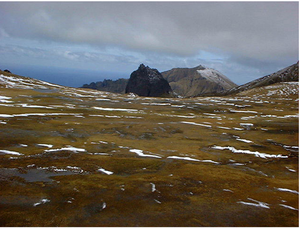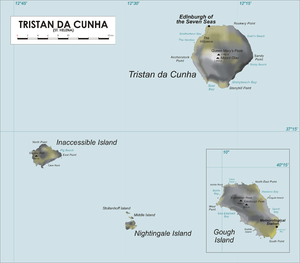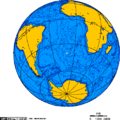- Gough Island
-
Gough and Inaccessible Islands * UNESCO World Heritage Site

Country United Kingdom Type Natural Criteria vii, x Reference 740 Region ** Europe and North America Inscription history Inscription 1995 (19th Session) Extensions 2004 * Name as inscribed on World Heritage List
** Region as classified by UNESCOGough Island (/ˈɡɒf/, rhymes with cough), also known historically as Gonçalo Álvares or Diego Alvarez, is a volcanic island in the South Atlantic Ocean. It is a dependency of Tristan da Cunha and part of the British overseas territory of Saint Helena, Ascension and Tristan da Cunha. It is uninhabited except for the personnel of a weather station (usually six people) which the South African National Antarctic Programme has maintained continually on the island since 1956. It is one of the most remote places with a constant human presence.
Contents
Geography and geology
Gough Island rises to heights of over 900 m (2,953 ft) above sea level. Its area is 35 square miles (91 km2) according to the South African Antarctic Programme.[1] It is located at 40°19′05″S 9°56′07″W / 40.3181°S 9.9353°WCoordinates: 40°19′05″S 9°56′07″W / 40.3181°S 9.9353°W. Topographic features include the highest Peak, Edinburgh Peak, Hags Tooth, Mount Rowett, Sea Elephant Bay, Quest Bay, and Hawkins Bay.
It includes small satellite islands and rocks such as Southwest Island, Saddle Island (South), Tristiana Rock, Isolda Rock (West), Round Island, Cone Island, Lot's Wife, Church Rock (North), Penguin Island (Northeast), and The Admirals (East). It is a remote and lonely place, about 400 kilometres (250 mi) southeast of the other islands in the Tristan da Cunha group, 2,700 kilometres (1,700 mi) from Cape Town, and over 3,200 kilometres (2,000 mi) from the nearest point of South America.
History
The first recorded discovery of Gough Island was in 1505 or 1506 by the Portuguese explorer Gonçalo Álvares. Maps during the next three centuries named the island for him. On some later maps, this was given as Diego Alvarez.
According to some historians, the English merchant Anthony de la Roché was the first to land on the island, in April 1675.[2]
Charles Gough rediscovered the island in 1731, thinking it was a new find. It has since been named for him.
- It was named Gonçalo Alvarez, after the captain of Vasco da Gama's flagship on his epic voyage to the east, and under this name it was marked with reasonable accuracy on the charts of the South Atlantic during the following 250 years. Then, in 1731, Captain Gough of the British ship Richmond reported the discovery of a new island, which he placed 400 miles to the east of Goncalo Alvarez. Fifty years later cartographers realized that the two islands were the same and despite the priority of the Portuguese discovery, and the greater accuracy of the position given by them, "Gough's Island" was the name adopted. [3]
Wildlife
Gough and Inaccessible Island are a protected wildlife reserve, which has been designated a World Heritage Site by UNESCO. It has been described as one of the least disrupted ecosystems of its kind and one of the best shelters for nesting seabirds in the Atlantic. In particular, it is host to almost the entire world population of the Tristan Albatross (Diomedea dabbenena) and the Atlantic Petrel (Pterodroma incerta).[4] However, this status is now in doubt as in April 2007 researchers published evidence that predation by introduced house mice on seabird chicks is occurring at levels that might drive the Tristan Albatross and the Atlantic Petrel to extinction.[5] The island is also home to the almost flightless Gough Island Moorhen,[6] and the critically endangered Gough Bunting.
The Royal Society for the Protection of Birds has since been awarded £62,000 by the UK government's Overseas Territories Environment Programme to fund additional research on the Gough Island mice and a feasibility study of how best to deal with them. The grant will also pay for the assessment of a rat problem on Tristan da Cunha island.
Weather station
The weather station on Gough Island is operated as part of the network of the South African Weather Service. Because cold fronts approach South Africa from the south-west, the Gough station is particularly important in forecasting winter weather.
The Gough Island teams consist of:
- a senior meteorologist
- two junior meteorologists
- a radio technician
- a medic
- a diesel mechanic
- biologists (depending on ongoing research projects)
Maps
References
- ^ http://www.sanap.ac.za/sanap_gough/sanap_gough.html
- ^ Wace N.M. (1969). "The discovery, exploitation and settlement of the Tristan da Cunha Islands". Proceedings of the Royal Geographical Society of Australasia (South Australian Branch) 10: 11–40.
- ^ Heaney, J.B., Holdgate, M.W. (1957). The Gough Island Scientific Survey.The Geographical Journal, Vol. 123, No. 1, pp. 20-31
- ^ Cuthbert, J. & Sommer, E. Population size and trends of four globally threatened seabirds at Gough Island, South Atlantic Ocean. Marine Ornithology 32: 97–103.
- ^ R M Wanless, A Angel, R J Cuthbert, G M Hilton and P G Ryan (2007). "Can predation by invasive mice drive seabird extinctions?". Biology letters 3 (3): 241–244. doi:10.1098/rsbl.2007.0120. PMC 2464706. PMID 17412667. http://www.pubmedcentral.nih.gov/articlerender.fcgi?tool=pmcentrez&artid=2464706.
- ^ Roots, Clive (2006). Flightless birds. Westport, Conn.: Greenwood Press. p. 60. ISBN 0313335451. http://books.google.com/?id=Sb1IJYzXZhUC&pg=RA1-PA60&lpg=RA1-PA60&dq=%22george+Comer%22+antartica. Retrieved 2008-03-31.
External links
- The South African Weather Station on Gough Island - Official website.
- Wiki site for Southern Ocean Islands and Antarctica
- Web site for the 54th South-African expedition to Gough Island[dead link]
- Gough Island on GlobalGuide
- Map of Gough Island, with PDF downloadable
- The South Atlantic and Subantarctic Islands: Gough Island
- UNESCO Gough & Inaccessible Islands Wildlife Reserve
- Photographs by one of the South African Weather Station staff who was based on Gough Island.
Tristan da Cunha · Inaccessible Island · Nightingale Islands (Nightingale Island · Middle Island · Stoltenhoff Island) · Gough Island
 Saint Helena
Saint HelenaAscension Island  Tristan da Cunha
Tristan da CunhaJamestown (capital)
Half Tree Hollow
Saint Paul's
LongwoodGeorgetown (chief settlement)
Two Boats Village
RAF Ascension IslandEdinburgh of the Seven Seas
Gough IslandOutlying territories of European countries Territories under European sovereignty but closer to or on continents other than Europe (see inclusion criteria for further information)Denmark France Italy Netherlands Norway Portugal Spain United
KingdomAnguilla · Bermuda · British Virgin Islands · Cayman Islands · Falkland Islands · Montserrat · Saint Helena, Ascension and Tristan da Cunha · Turks and Caicos Islands · British Antarctic Territory · British Indian Ocean Territory · Pitcairn Islands · South Georgia and the South Sandwich IslandsCategories:- World Heritage Sites in the United Kingdom
- Islands of Tristan da Cunha
- Volcanoes of Tristan da Cunha
- Seabird colonies
- South African National Antarctic Programme
- Maritime history of South Africa
Wikimedia Foundation. 2010.




